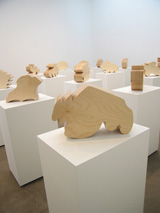 Allan McCollum 7,056 Shapes Monoprints, each unique. 2005/06. |
|
Light & Shapes, Enough for Everyone By DAVID GROSZ On May 25, 1963, Dan Flavin installed an 8-foot fluorescent fixture at a 45-degree angle on the wall of his studio. With this simple gesture, he defined the terms of his subsequent artistic career and also inaugurated one of the signature icons of 1960s Minimalism.
The small Flavin show at Paula Cooper Gallery gathers one piece from the original May 25, 1963, series and three other diagonals made during the next 20-odd years. The progression suggests that the artist himself may have anticipated how his work would look to future generations. There is a great distance between the brash self-assertion of "The Diagonal of May 25, 1963" and the softer-edged allusiveness of "untitled (to V. Mayakovsky) 2," from 1987. The later sculpture comprises eight 4-foot red fixtures placed side by side in a pattern of slightly raised then slightly lowered diagonals. The work pays homage to the Futurist poet and the utopian avant-garde he represents (the red hue references Bolshevism). But it eschews the irregular cadence of Mayakovsky's free-verse for a simple singsong rhythm, and the poet's spirited innovation — its radicalism so difficult to transmit to subsequent eras — is lost in a generalized celebration of form and light. The passing of time has also softened Flavin's work. And yet, though today it seems less polemic than lyric, its incandescent glow remains a beacon, illuminating vast stretches of the artistic present. ***
His latest installation, titled "Who's Afraid of Red Yellow and Blue3" after the famous Barnett Newman paintings, attempts to carry the painter's two-dimensional exploration of primary color into a third dimension. The work comprises three implied volumes, each defined by a 16-foot-by-22-foot floor of lacquered aluminum panels (red, yellow, and blue), and an identical ceiling (suspended by cables from the gallery rafters). The walls are nonexistent, so the viewer can look through the entire structure, walk in the narrow corridors of negative space separating the three "rooms," or gaze from outside of the space into it. The viewer can also step into the three volumes, which would mean stepping onto the work, yet the structure offers no compelling reason to cross its many thresholds since there is nothing there. And so, despite its bright colors and seemingly inviting, wide-open display, the installation heightens our awareness of the difference between inside and outside, between touch and sight. Unfortunately, these invisible walls are as close as the work comes to generating friction. However refreshing the insistence of "Who's Afraid" that it has no meaning — ideological, conceptual, or didactic — other than the viewer's experience of it, in the end the work offers little more than benign diversion. Mr. Flavin's fixtures may have lost some of their shock value, yet they manage to maintain redeeming edginess though their intimations of claustrophobia and radiation and the engagement of surrounding darkness. Compared with this, Mr. Irwin's installation is all sunny veneer. Linger too long and you realize that boredom, not fear, is its real nemesis. *** A more engaging response to the art of the 1960s comes from Allan McCollum, one of several artists emerging in the 1980s to borrow Minimalism's reductive forms and infuse them with new content.
So far, the artist has developed 214,990,848 of these amoeboid Rorschach-like forms, many of which are contained in a long bookshelf's worth of black binders inside the doorway to Friedrich Petzel Gallery. More important than the already designed shapes, however, is the blueprint for the creation of the remaining billions — a project that Mr. McCollum will be unable to complete in his lifetime and must therefore entrust to future generations. To give some sense of his shapes' aesthetic and practical application, he has reproduced a small number of them in two installations. In the gallery's main room, several thousand — represented as black silhouette monoprints on a white ground, each in a small black frame — stand on a terraced platform in 98 rows, like a disciplined army in flawless formation. A tiny fraction of the total project, this imposing arrangement gives a sense of its awesome overall scale. In the back room, a second installation — 25 plywood birch sculptures on white pedestals — emphasizes the elegant distinctiveness of the individual forms.
Flavin until December 22 (534 W. 21st St., between Tenth and Eleventh avenues, 212-255-1105); Irwin until January 27 545 W. 22nd St., between Tenth and Eleventh avenues, 212-989-4258); McCollum until December 23 (535 W. 22nd St., between Tenth and Eleventh avenues, 212-680-9467). |




